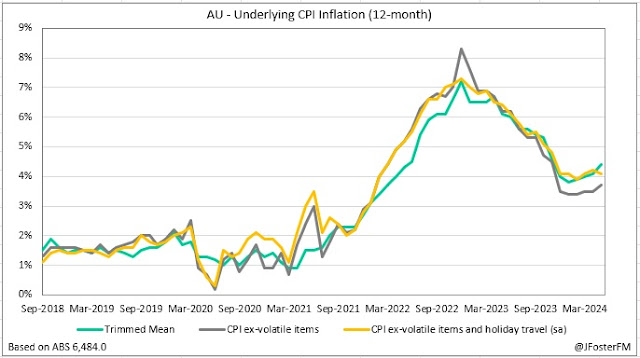A messy tape across markets this week factored in encouraging US inflation data, uncertainty going into the weekend's French elections and month- and quarter-end flows. Domestically, inflation data has revamped RBA hike pricing. Reflecting upon the first half of the year, the key theme that stands out is the reappraisal of the Fed easing cycle. The US 2-year yield climbed 50bps as rate cuts were priced out and the timing of the first cut was pushed back well into the second half of the year. This saw the US dollar surge against the yen but weaken against other majors. US equities still rallied strongly and Japan gained 18%.
Inflation trending in the wrong direction in Australia has upped hawkish bets on the RBA resuming its tightening cycle. Pricing for an August hike lifted to around a 50/50 prospect from just a 10% chance last week after the May CPI release reported a third consecutive rise in the 12-month headline inflation rate to 4% (prior 3.6%, consensus 3.8%). Additionally, an increase in services inflation (4.8%yr) underpinned firmer readings for the underlying CPI measures, with the trimmed mean rising from 4.1% to 4.4%yr. Comments from RBA officials during the week were generally consistent with the theme of the Board's reluctance to tighten further. Assistant Governor Kent - speaking before the CPI release - noted that financial conditions in Australia are restrictive, putting downward pressure on inflation by slowing aggregate demand. On Thursday evening (post CPI) Deputy Governor Hauser during Q&A following his maiden speech cautioned against overreacting to the partial reading of inflation provided in the May report, highlighting the comprehensive quarterly data set for Q2 CPI (due 31 July) as the one to watch.
As discussed in my CPI review (see here), the situation is more nuanced than concluding Australia is facing a greater inflation challenge than in peer economies. Services inflation in Australia is no higher than overseas; the main difference is that goods prices have not seen anywhere near the same extent of disinflation. Something also to factor in is the effect of upcoming energy rebates that will lower the measured inflation rate. That said, those rebates and other measures, including the stage 3 tax cuts that come into effect next week, could boost demand and slow the disinflationary process. There is a lot for the RBA to consider at its August forecast round and still a range of key inputs to come before then, all with the potential to shift rates pricing.
Switching to the US where the May personal spending and income data was this week's key risk event. Inflationary pressures eased in line with expectations, the headline PCE deflator softened from 2.7% to 2.6%yr and the core PCE deflator - the Fed's preferred gauge - slowed from 2.8% to 2.6%yr, a low back to March 2021. The monthly changes - 0% headline and 0.1% core - were soft readings that if sustained will open the door to Fed easing, potentially in September. In support of that scenario, the consumption data continued to show signs of slowing household demand. Real spending was up 0.3%m/m (2.4%yr) to be tracking at just a 0.3% pace through the first 5 months of 2024, well down from a robust 1.8% over the back half of 2023.
The Bank of England's Financial Stability Report noted that the global adjustment to higher interest rates was not yet complete and markets, priced for soft landings, remain vulnerable to a scenario where that does not eventuate. Key risks relate to weaker economic growth, stickier inflation dynamics and geopolitical tensions. In Europe, inflation readings eased in Spain (3.8% to 3.5%yr) and France (2.6% to 2.5%yr), indicating that next week's report for the euro area is likely to show an easing in inflation (2.5% expected) after increasing in May (2.6%). Meanwhile, the ECB's latest measure of consumer inflation expectations reported declines to 2.8% (from 2.9%) and 2.3% (from 2.4%) on a one-year and three-year horizon respectively.

























































